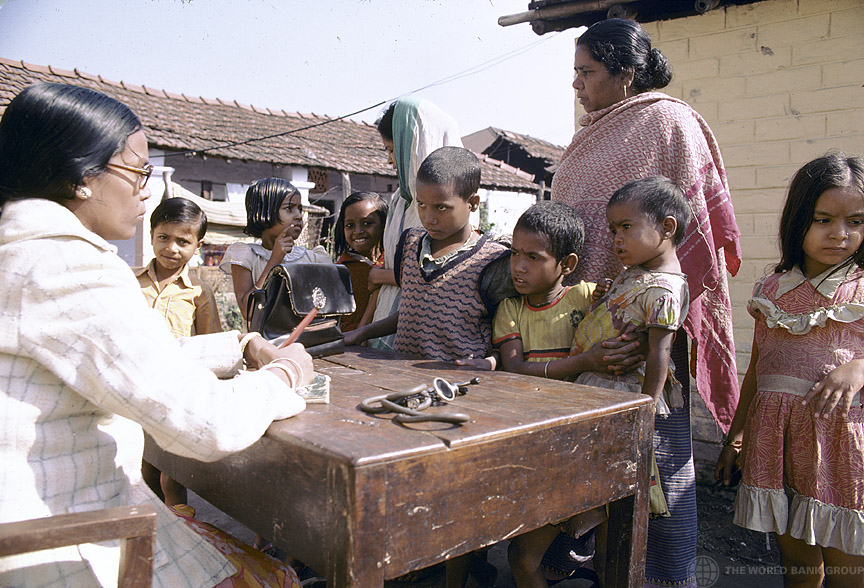Anaemia among patients with visceral leishmaniasis and haematological dynamics post treatment
Anaemia among patients with visceral leishmaniasis and haematological dynamics post treatment

In patients with visceral leishmaniasis (VL), anaemia is a classical haematological sign at presentation. The baseline haemoglobin levels are usually around 7–10 g/dL but can be as low as 4 g/dL [1]. Data from clinical trials indicate that the disease induced haematological loss is around 6–7 g/dL on average [2]. The anaemia in VL patients arises due to one or more of the following: haemolysis of the parasitised reticulo-endothelial cells in the spleen, bone marrow suppression and dyserythropoeisis, bleeding, or due to iron deficiency [1,3–7]. The severity of anaemia at diagnosis tends to increase with the duration of clinical illness and is exacerbated by iron deficiency and co-infection with helminths [8,9]. Initiation of treatment may lead to further haematological insult as indicated in a recent publication following single-dose liposomal amphotericin B [10]. However, the temporal dynamics of haematological parameters following treatment remains to be fully understood. This study group aims to characterise the haematological parameters at baseline and during the initial treatment and the ensuing follow-up period using individual participant data hosted at IDDO VL data platform.
The specific objectives are:
- To identify host (including age, sex, gender, clinical characteristics) and parasite (initial load) determinants associated with anaemia at presentation
- To characterise the haematological dynamics during the treatment phase including assessment of any potential drug related (mg/kg drug dosage) haematological insult
- To quantify VL attributable fall in haemoglobin concentration using the longitudinal haematological trajectory if available
- Prospective clinical efficacy studies in patients with parasitologically and/or serologically confirmed VL
- Information on name, date and dose of treatment regimen
- Baseline data on age and gender
- Data on haemoglobin or haematocrit at baseline and at least two further time-points during treatment or at follow-up
- Information of WBC, Platelets and differential cell counts
- Methodology used for haematological quantification, e.g. name of devices
- Blood transfusion status before, during or after treatment
- Co-administration of iron supplement
- Information on type of anaemia (e.g.: normocytic, aplastic)
- Duration of illness at presentation and other clinical characteristics such as baseline parasite load
- History of disease or treatment including information regarding if the infection is primary or relapsing/unresponsive/resistant cases
- Information on concomitant illness such as HIV, TB or malaria
- Information on severity of disease (mild, moderate or severe VL)
- Anthropometric indicators e.g. weight, height
Data uploaded to the IDDO VL data platform will be standardised according to the IDDO VL data standardisation protocol into a single database of quality-assured individual patient data using recently developed VL CDISC standards [11]. A detailed statistical analysis plan will be developed and published in an appropriate journal prior to the analyses and will be shared among data contributors beforehand.
The Study Group comprises participating investigators who contribute relevant data sets to the pooled analysis. Data sets will remain the property of the investigators. The Study Group collectively makes decisions with respect to including additional studies, data analysis and plans for publication, in line with the IDDO Publication Policy [12]. The Study Group will identify one or two people to coordinate activities including data analysis, and drafting of publications and reports for group review.
Dr Prabin Dahal and Dr Sauman Singh will be responsible for statistical analyses and co-leading the study group. For further information, please contact prabin.dahal@iddo.org; sauman.singh@iddo.org.
1. Boelaert M, Sundar S. Leishmaniasis. Manson’s Trop. Dis. Twenty-Third Ed. 2013;631–51.
2. Thakur CP, Kumar M, Pandey AK. Evaluation of efficacy of longer durations of therapy of fresh cases of kala-azar with sodium stibogluconate. Indian J Med Res. 1991;93:103–10.
3. Das A, Sen Gupta P. Relapse of kala azar after splenectomy. Lancet. 1950;1:681–3.
4. Woodruff AW, Topley E, Knight R, Downie CGB. The Anaemia of Kala Azar. Br. J. Haematol. 1972;22:319–29.
5. Woodruff AW. Recent work on anaemias in the tropics. Br. Med. Bull. 1972;28:92–5.
6. Woodruff AW. Mechanisms involved in anaemia associated with infection and splenomegaly in the tropics. Trans. R. Soc. Trop. Med. Hyg. 1973;67:313–25.
7. Rees PH, Kager PA, Wellde BT, Hockmeyer WT. The response of Kenyan kala-azar to treatment with sodium stibogluconate. Am. J. Trop. Med. Hyg. 1984;33:357–61.
8. Thakur CP. Epidemiological, clinical and therapeutic features of Bihar kala-azar (including post kala-azar dermal leishmaniasis). Trans. R. Soc. Trop. Med. Hyg. 1984;78:391–8.
9. Chulay JD, Bhatt SM, Muigai R, Ho M, Gachihi G, Were JBO, et al. A Comparison of 3 Dosage Regimens of Sodium Stibogluconate in the Treatment of Visceral Leishmaniasis in Kenya. J. Infect. Dis. 1983;148:148–55.
10. Mondal D, Alvar J, Hasnain MG, Hossain MS, Ghosh D, Huda MM, et al. Efficacy and safety of single-dose liposomal amphotericin B for visceral leishmaniasis in a rural public hospital in Bangladesh: A feasibility study. Lancet Glob. Heal. 2014;2:e51–7.
11. IDDO. New global collaboration developing standards for standardised data collection across the VL research community [Internet]. iddo.org. 2020 [cited 2020 Nov 15]. Available from: https://www.iddo.org/news/new-global-collaboration-developing-standards-standardised-data-collection-across-vl-research
12. WWARN Policy on Data Use and Publication. https://www.wwarn.org/tools-resources/publication-policy. Updated: 16th April 2019.


